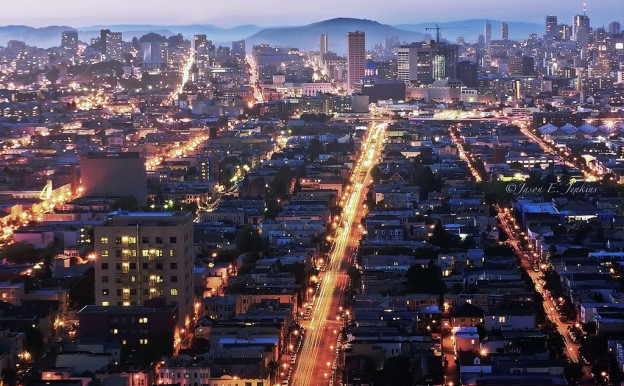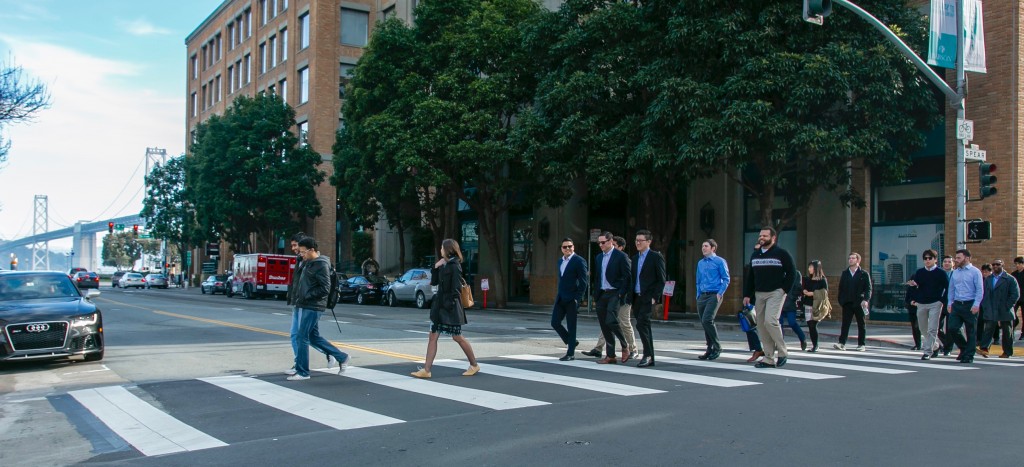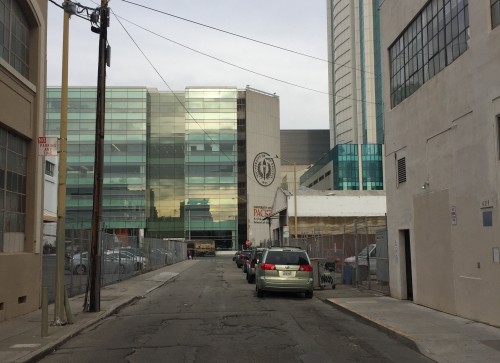

In late January, first-year students in the Baker Program in Real Estate attended the first annual domestic real estate trek as part of the program’s newly revised curriculum. For this inaugural trip, students visited San Francisco and Silicon Valley, two of the nation’s most active real estate markets. This article is the first part in a three-part series highlighting the trip.

Over the course of the past decade, few cities have come close to experiencing the booming commercial real estate activity that has been witnessed in San Francisco. The city’s thriving tech economy has caused valuations and rents to skyrocket and construction cranes to dot the skyline. Nowhere has this activity been more concentrated than in the area south of Market Street (known by the locals as SoMa). In an effort to help Baker Program students grasp just how much this area is changing, the 2016 trek began with a walk down Mission Street.
The first stop of the day was Gensler’s design studio located at 2 Harrison Street, a historic landmark building that was once home to Hills Bros. Coffee. Students enjoyed a presentation by Gensler architect Ben Tranel, who spoke on the evolution of SoMa caused by increased demand from tech companies. Central to Tranel’s message was an argument that traditional offices are dying out, and more and more companies are demanding creative office environments that blur the lines between work life and home life. Tranel could not have chosen a more appropriate setting for his presentation, a former coffee roasting plant previously on the edge of development, now a cutting edge workplace at the epicenter of the creative office revolution. Students were treated to a tour of Gensler’s office space where they witnessed firsthand an inspiring creative office environment, adapted for reuse from a truly magnificent historic building.

Baker students then journeyed down Mission Street, encountering a beehive of construction activity. Mission Street, which was named for the Spanish Mission founded in 1776, has in recent years become the location of choice for the tech industry’s creative office movement. Observant students were able to catch a glimpse of steel just beginning to rise at the future home of the Salesforce Tower. Once completed, this tower will be the tallest building west of the Mississippi, and will be anchored by the tech giant Salesforce.
Students next stopped at the office of SPUR, a non-profit research and advocacy organization. SPUR’s mission is to promote beneficial urban planning and governance in the San Francisco Bay Area. Students were privileged to meet with Benjamin Grant, an Urban Design Policy Director working for the organization. Grant addressed several of the major planning issues facing the city and region, with an emphasis on how San Francisco can best cope with the housing affordability crisis. It was enlightening for students to get an insider’s perspective on some of the issues and practices that have made San Francisco the thriving urban environment that it is today, and what it needs to do to maintain its vibrant and eclectic nature.

“It was amazing to learn about SPUR’s century-long contributions in making a better San Francisco by promoting good housing, community, transportation, and regional planning. It opened my eyes to the many complexities that accompany urban development.” -Amin Elahy, Baker Program 2017
Continuing down Mission Street, Baker students visited the San Francisco Chronicle building, future home of the 5M Project, a mixed use development led Forest City. Students were given a tour of the 4-acre property by Andy Wang, a Forest City Development Associate. When completed, the site will contain three new towers, and will add much needed apartments, condos, and office space to a severely supply-constrained submarket. Uniquely, the site will also contain nearly 50,000 square feet of open public space. Wang spoke of specific challenges facing the site, including a current lawsuit and backlash from the community arising from fears of gentrification and displacement. Drawing upon principles they had studied in their first semester of the Baker Program, students were better able to comprehend the tenacity and endurance required by a developer during these early phases of such a transformational and controversial development project.
“Walking through the 4-acre 5M site, I was amazed by the vision of an urban mixed-use development consisting of open public place, affordable housing, market-rate housing, traditional office buildings, co-working space, and retail space. It was definitely a unique experience to see firsthand the zoning, planning and development process we’ve read about in our textbooks. -Yang Yang, Baker Program 2017

Walking down Mission Street, students of the Baker Program were given a unique opportunity to experience the history of urban development in San Francisco. The dynamic nature of a city in transition was evidenced from a coffee plant adapted for creative use, to new mixed-use construction that will forever alter the landscape of the city. Students experienced in real-time the vitality that such progress can bring to a city, while also being exposed to the difficult realities of affordability and gentrification that follow such dramatic urban expansion. Within just a few city blocks, and free from the constraints of a classroom setting, Baker students gained invaluable insights that will dramatically enrich the rest of their educational experiences at Cornell.
The following day, Baker students visited Menlo Park, a very different city than the one they had just been exposed to. At BootUp World, City Housing and Economic Development Manager Jim Cogan spoke with students about the struggles of being a small city and coping with the challenges of housing Facebook, one of the world’s largest tech companies. To read more about the Baker Program’s visits to Facebook and Google headquarters, stay tuned for Baker Program San Francisco Trek: Part 2.
